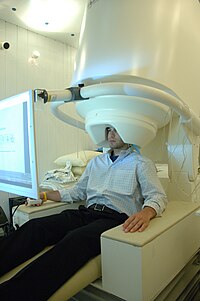
Photo from wikipedia
Magnetoencephalography (MEG) is particularly well‐suited to the study of human motor cortex oscillatory rhythms and motor control. However, the motor tasks studied to date are largely overly simplistic. This study… Click to show full abstract
Magnetoencephalography (MEG) is particularly well‐suited to the study of human motor cortex oscillatory rhythms and motor control. However, the motor tasks studied to date are largely overly simplistic. This study describes a new approach: a novel event‐based simulated drive made operational via MEG compatible driving simulator hardware, paired with differential beamformer methods to characterize the neural correlates of realistic, complex motor activity. We scanned 23 healthy individuals aged 16–23 years (mean age = 19.5, SD = 2.5; 18 males and 5 females, all right‐handed) who completed a custom‐built repeated trials driving scenario. MEG data were recorded with a 275‐channel CTF, and a volumetric magnetic resonance imaging scan was used for MEG source localization. To validate this paradigm, we hypothesized that pedal‐use would elicit expected modulation of primary motor responses beta‐event‐related desynchronization (B‐ERD) and movement‐related gamma synchrony (MRGS). To confirm the added utility of this paradigm, we hypothesized that the driving task could also probe frontal cognitive control responses (specifically, frontal midline theta [FMT]). Three of 23 participants were removed due to excess head motion (>1.5 cm/trial), confirming feasibility. Nonparametric group analysis revealed significant regions of pedal‐use related B‐ERD activity (at left precentral foot area, as well as bilateral superior parietal lobe: p < .01 corrected), MRGS (at medial precentral gyrus: p < .01 corrected), and FMT band activity sustained around planned braking (at bilateral superior frontal gyrus: p < .01 corrected). This paradigm overcomes the limits of previous efforts by allowing for characterization of the neural correlates of realistic, complex motor activity in terms of brain regions, frequency bands and their dynamic temporal interplay.
Journal Title: Human Brain Mapping
Year Published: 2023
Link to full text (if available)
Share on Social Media: Sign Up to like & get
recommendations!